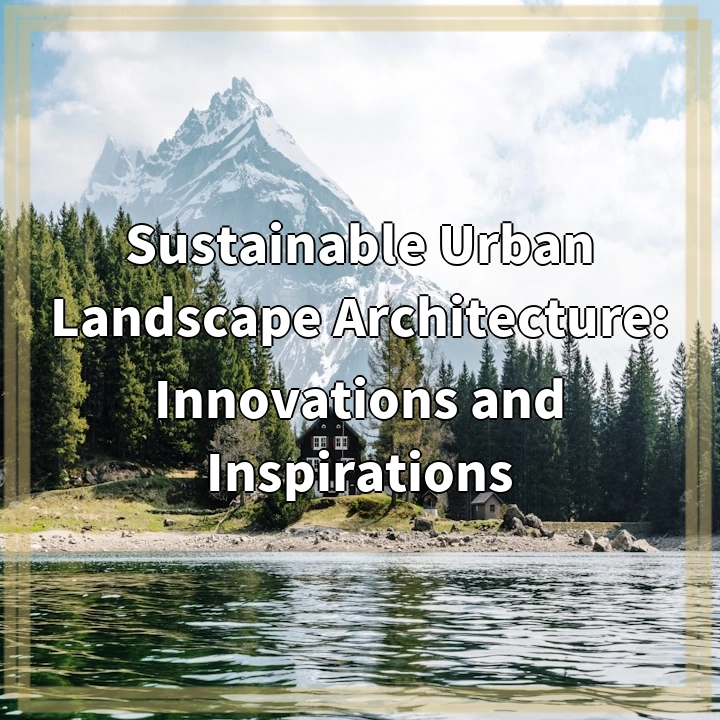
What it is:
Sustainable Urban Landscape Architecture is an approach that integrates ecological principles into the design and management of urban spaces. It aims to create environments that are not only aesthetically pleasing but also functional and resilient in the face of climate change and urbanization challenges. By considering factors such as biodiversity, water management, and community engagement, sustainable landscape architecture strives to enhance urban livability while minimizing environmental impacts.
Key Principles of Sustainable Urban Landscape Architecture
1. **Biodiversity Enhancement:** Incorporating native plant species and creating habitats can support local wildlife, promote pollination, and improve ecosystem health.
2. **Water Management:** Implementing sustainable drainage systems, rain gardens, and green roofs helps manage stormwater runoff, reduce flooding, and replenish groundwater.
3. **Community Involvement:** Engaging local communities in the design process ensures that spaces meet the needs of residents and fosters a sense of ownership and responsibility.
Real-World Problems
Despite the benefits of Sustainable Urban Landscape Architecture, numerous challenges hinder its widespread adoption:
1. Urban Sprawl
As cities expand rapidly, green spaces are often sacrificed for development. This urban sprawl diminishes the potential for incorporating sustainable practices and contributes to habitat loss and increased pollution.
2. Climate Change Impact
Extreme weather events, such as flooding and heat waves, stress existing urban landscapes. These challenges require innovative solutions that can adapt to changing climatic conditions while providing essential services to urban populations.
3. Lack of Funding
Many municipalities struggle with limited budgets, which can result in inadequate investment in sustainable landscape projects. This financial constraint often hampers the ability to implement green infrastructure solutions effectively.
4. Public Awareness and Engagement
There may be a lack of understanding among the public regarding the benefits of sustainable landscape architecture. Without community support and engagement, projects may face resistance or fail to meet local needs.
5. Policy and Planning Barriers
Existing zoning laws and regulations can impede the implementation of sustainable practices. Policymakers must address these barriers to foster an environment conducive to innovative landscape design.
Call to Action
Promoting Sustainable Urban Landscape Architecture requires a collaborative effort from designers, policymakers, and community members. By advocating for sustainable principles and addressing real-world challenges, we can create resilient urban environments that thrive. Together, we can inspire a movement towards greener, healthier cities.

Solutions to Challenges in Sustainable Urban Landscape Architecture
Addressing the challenges of Sustainable Urban Landscape Architecture involves a multifaceted approach that combines innovative design, community engagement, and supportive policies. Here are some effective solutions:
1. Strategic Urban Planning
City planners should prioritize preserving green spaces and incorporating sustainable practices in urban development. Creating comprehensive land-use plans that balance development and conservation can mitigate urban sprawl and protect natural habitats.
2. Green Infrastructure Investment
Investing in green infrastructure, such as rain gardens, permeable pavements, and green roofs, can significantly improve water management and enhance urban resilience to climate change. Encouraging public-private partnerships can also help secure funding for such projects.
3. Community Education and Involvement
Raising awareness about the benefits of sustainable urban landscapes can empower communities to advocate for green initiatives. Hosting workshops and public forums can foster collaboration and ensure the design process reflects local needs and values.
4. Policy Revisions
Updating zoning laws and regulations to support sustainable practices is crucial. Policymakers should work to remove barriers and create incentives for the adoption of sustainable landscape architecture, such as tax credits or grants for green projects.
5. Climate Adaptation Strategies
Developing adaptive landscape designs that can withstand extreme weather events is essential. Implementing solutions like native planting, which requires less water and maintenance, can enhance biodiversity while promoting ecological resilience.
Conclusion
By implementing these solutions, cities can move toward more sustainable urban landscapes that benefit both the environment and their residents. Collaborative efforts between planners, communities, and policymakers can pave the way for vibrant and resilient urban spaces.















